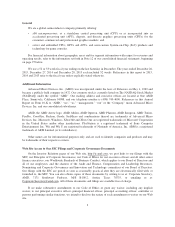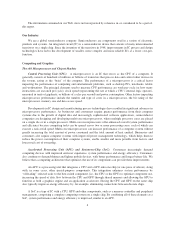AMD 2015 Annual Report Download - page 16
Download and view the complete annual report
Please find page 16 of the 2015 AMD annual report below. You can navigate through the pages in the report by either clicking on the pages listed below, or by using the keyword search tool below to find specific information within the annual report.We work closely with our customers to define product features, performance and timing of new products so
that the products we are developing meet our customers’ needs. We also employ application engineers to assist
our customers in designing, testing and qualifying system designs that incorporate our products. We believe that
our commitment to customer service and design support improves our customers’ time-to-market and fosters
relationships that encourage customers to use the next generation of our products.
We work closely with our customers to create differentiated products that leverage our CPU, GPU and APU
technology. Customers of our semi-custom products pay us non-recurring engineering fees for design and
development services and a purchase price for the resulting semi-custom products.
Collectively, our top five customers accounted for approximately 68% of our net revenue during the year
ended 2015. In 2015, Microsoft Corporation and Sony Corporation each accounted for more than 10% of our
consolidated net revenues. Sales to Microsoft and Sony consisted primarily of products from our Enterprise,
Embedded and Semi-Custom segment. Five customers accounted for approximately 53% of the net revenue
attributable to our Computing and Graphics segment. In addition, five customers, including Sony and Microsoft,
accounted for approximately 95% of the net revenue attributable to our Enterprise, Embedded and Semi-Custom
segment. A loss of any of these customers would have a material adverse effect on our business.
Original Equipment Manufacturers
We focus on three types of OEM customers: multi-nationals, selected regional accounts and target market
customers. Large multi-nationals and regional accounts are our core OEM customers. Our OEM customers
include numerous foreign and domestic manufacturers of servers and workstations, desktops, notebooks, PC
motherboards and game consoles.
Third-Party Distributors
Our authorized channel distributors resell to sub-distributors and mid-sized and smaller OEMs and ODMs.
Typically, distributors handle a wide variety of products, and may include those that compete with our products.
Distributors typically maintain an inventory of our products. In most instances, our agreements with distributors
protect their inventory of our products against price reductions and provide return rights with respect to any
product that we have removed from our price book that is not more than 12 months older than the manufacturing
code date. In addition, some agreements with our distributors may contain standard stock rotation provisions
permitting limited levels of product returns.
Add-in-Board (AIB) Manufacturers and System Integrators
We offer component-level graphics and chipset products to AIB manufacturers who in turn build and sell
board-level products using our technology to system integrators (SIs), and to retail buyers. Our agreements with
AIBs protect their inventory of our products against price reductions. We also sell directly to our SI customers.
SIs typically sell from positions of regional or product-based strength in the market. They usually operate on
short design cycles and can respond quickly with new technologies. SIs often use discrete graphics solutions as a
means to differentiate their products and add value to their customers.
Competition
Generally, the IC industry is intensely competitive. Products typically compete on timely product
introductions, product quality (including enabling state-of-the art visual experiences), power consumption
(including battery life), reliability, processor clock speed, performance, size (or form factor), selling price, cost,
adherence to industry standards (and the creation of open industry standards), level of integration, software and
hardware compatibility and stability, brand recognition and availability. Technological advances in the industry
can result in frequent product introductions, regular price reductions and short product life cycles for some
10
























